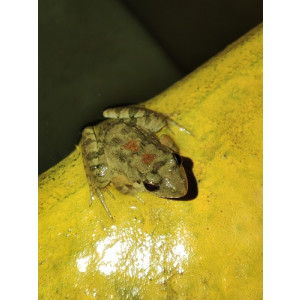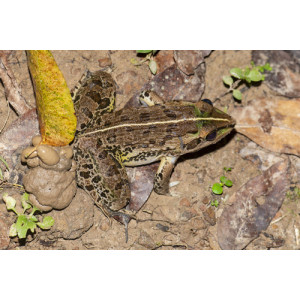Crab-eating Frog Did you see this animal?
Scientific Name : Fejervarya cancrivora
Family : Dicroglossidae
Order : Anura
Class : Amphibia
Phylum : Chordata
Other Name : Crab-eating Frog, Marsh Frog, Brackish Water Frog, Mangrove Frog
Habitat : Mangrove forest and semi-evergreen forests.
Description : The crab eating frog, also known as the mangrove frog, is a species of tree frog. As its name suggests, this frog has a unique diet that includes crabs as one of its main food sources.
Crab eating frogs have adapted to living in mangrove forests and other coastal areas where crabs are abundant. They have large, sticky toe pads that allow them to climb trees and bushes to hunt for their prey. When hunting for crabs, the frog waits patiently until a crab comes within range. It then uses its long, sticky tongue to quickly snatch up the crab and bring it into its mouth.
Despite its name, the crab eating frog does not solely rely on crabs for its diet. It also feeds on other small insects and invertebrates, such as flies, moths, and spiders. In fact, crabs make up only a small portion of their diet.
The crab eating frog's unique diet helps to control the population of crabs in their habitat. By preying on crabs, the frog helps to maintain a balance in the ecosystem, ensuring that the crab population does not become too large and disrupt the delicate balance of the mangrove ecosystem.
In addition to their important ecological role, crab eating frogs are also fascinating creatures to observe in their natural habitat. Their unique hunting strategy and ability to climb trees make them a fascinating species to study and observe.
Overall, the crab eating frog is a fascinating and important species in the ecosystem of Southeast Asia's coastal regions. Its ability to adapt to its environment and thrive on a diverse diet of insects and invertebrates, including crabs, helps to maintain the balance of its ecosystem and ensures its continued survival.
Crab eating frogs have adapted to living in mangrove forests and other coastal areas where crabs are abundant. They have large, sticky toe pads that allow them to climb trees and bushes to hunt for their prey. When hunting for crabs, the frog waits patiently until a crab comes within range. It then uses its long, sticky tongue to quickly snatch up the crab and bring it into its mouth.
Despite its name, the crab eating frog does not solely rely on crabs for its diet. It also feeds on other small insects and invertebrates, such as flies, moths, and spiders. In fact, crabs make up only a small portion of their diet.
The crab eating frog's unique diet helps to control the population of crabs in their habitat. By preying on crabs, the frog helps to maintain a balance in the ecosystem, ensuring that the crab population does not become too large and disrupt the delicate balance of the mangrove ecosystem.
In addition to their important ecological role, crab eating frogs are also fascinating creatures to observe in their natural habitat. Their unique hunting strategy and ability to climb trees make them a fascinating species to study and observe.
Overall, the crab eating frog is a fascinating and important species in the ecosystem of Southeast Asia's coastal regions. Its ability to adapt to its environment and thrive on a diverse diet of insects and invertebrates, including crabs, helps to maintain the balance of its ecosystem and ensures its continued survival.
Distribution in Bangladesh
References:
description written by: Md. Shalauddin, Department of Zoology, Jagannath University, Dhaka. Information sources: IUCN Red List Bangladesh-2015, Hasan 2014, Khan 2018 (Photographic guide to the wildlife of Bangladesh).photo credit:abdi-kun(www.inaturalist.org/people/abdi-kun),photo copyright: iNaturalist. more information please contact with us.
description written by: Md. Shalauddin, Department of Zoology, Jagannath University, Dhaka. Information sources: IUCN Red List Bangladesh-2015, Hasan 2014, Khan 2018 (Photographic guide to the wildlife of Bangladesh).photo credit:abdi-kun(www.inaturalist.org/people/abdi-kun),photo copyright: iNaturalist. more information please contact with us.






















